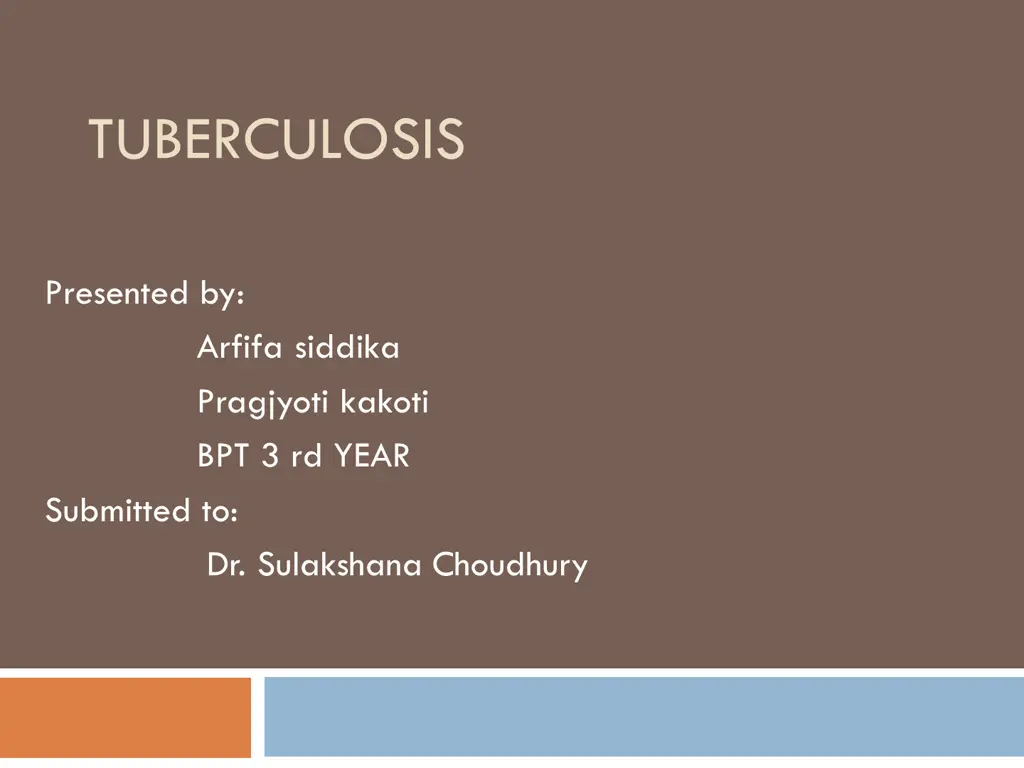Tuberculosis
The different types of tuberculosis, its clinical manifestations, pathophysiology, and how it spreads. Discover the signs and symptoms, diagnostic methods, and available treatment options for tuberculosis.
Download Presentation

Please find below an Image/Link to download the presentation.
The content on the website is provided AS IS for your information and personal use only. It may not be sold, licensed, or shared on other websites without obtaining consent from the author. Download presentation by click this link. If you encounter any issues during the download, it is possible that the publisher has removed the file from their server.
E N D
Presentation Transcript
TUBERCULOSIS Presented by: Arfifa siddika Pragjyoti kakoti BPT 3 rd YEAR Submitted to: Dr. Sulakshana Choudhury
CONTENT Introduction Clinical Manifestation Types Pathophysiology Epidemiology Spread of TB Sign and Symptoms Diagnosis Treatment
INTRODUCTION Tuberculosis (TB) is one of the most prevalent infections of human beings and contributes considerably to illness and death around the world. It is spread by inhaling tiny droplets of saliva from the coughs or sneezes of an infected person. It is slowly spreading chronic granulomatous bacterial infection characterized by gradual weight loss.
CLINICAL MANIFESATION Constitutional symptoms Anorexia Low grade fever Night sweats Weight loss Pulmonary symptoms Non resolving bronchopneumonia Chest tightness Chest pain
Extra pulmonary symptoms Pain Inflammation
TYPES Pulmonary Tuberculosis Extra Pulmonary Tuberculosis A. B.
PULMONARY TB Primary Tuberculosis : The infection of an individual who has not been previously infected is called Primary TB. Secondary Tuberculosis : The infection that individual who has been previously infected is called Secondary or Post primary TB.
EXTRA PULMONARY TB Lymph node TB : Seen frequently in HIV infected patient. symptoms: Painless swelling of lymph nodes most commonly at cervical and scrofula. Pleural TB : Involvement of pleura is common in primary TB and result from penetration of tubercle of bacilli into pleural space. TB of upper airways : Involvement of larynx , pharynx and epiglottis. symptoms: Dysphagia, chronic productive cough
Genitourinary TB : 15% of all extra pulmonary causes. Any part of the genitourinary tract get infected symptoms :Urinary frequency Skeletal TB : Involving if weight bearing parts like spine, hip, knee symptoms: pain in hip joint and knees, swelling of knee , trauma.
Gastrointestinal TB: Involvement of any part of GI tract. Symptoms: Abdominal pain, Diarrhea, Weight loss. TB Meningitis & Tuberculoma: 5% of all extra pulmonary TB
TB Pericardiatis: 1-8% of all extra pulmonary TB case. Spreads mainly in mediastinal or hilar nodes of from lungs. Miliary or disseminated TB: Results from Hematogenous spread of tubercle Bacilli. Spread is due to entry of infection into pulmonary vein producing. Less common Extra pulmonary TB: Painful Hypersensitivity related phlyctenular conjuctivis.
PATHOPHYSIOLOGY Myobacterium bacilli inhales Transmitted through airways to alveoli Multiplication Transfer to lymph system and blood stream (in cerebral cortex, kidney, bones) Immune system responds Phagocytes engulf o may bacteria TB lymphocytes bacilli spreads in normal tissues Accumulation of exudates in normal alveoli Bronchopneumonia
EPIDEMIOLOGY India is he highest TB country for more than one-fifth of global incidence.
According to World Health Organization (WHO) Estimates, India has the worlds largest tuberculosis epidemic. In 2020, India accounted 26% of he Incident TB cases across the globe. India has incidence rate of 192 cases per 100,000 of population
DIAGNOSIS Bacteriological test Sputum Culture test: Solid medium: 4-18 weeks Liquid medium: 8-14 days Agar medium: 7-14 days Radiography: Chest X-Ray
Nucleic acid amplification: Species identification; several hours Low sensitivity; high cost Most useful for rapid conformation of TB in persons with AFB-positive sputa Tuberculin skin test(PPD): Injection of fluid into the skin of the lower arm. 48-72 hours later checked for reaction. Diagnosis is based on the size of the wheal.
PREVENTION Isolation Cover the mouth Wear mask Finish entire course of medication Vaccination






















